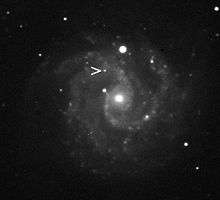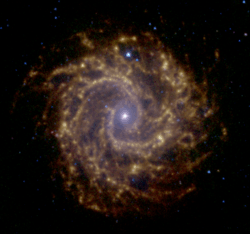NGC 3184
| NGC 3184 | |
|---|---|
|
Spiral galaxy NGC 3184 as observed with the Spitzer Space Telescope as part of the Spitzer Infrared Nearby Galaxy Survey. The blue colors represent the 3.6 micrometre emission from stars. The green and red colors represent the 5.8 and 8.0 micrometre emission from polycyclic aromatic hydrocarbons and possibly dustright. | |
| Observation data (J2000 epoch) | |
| Constellation | Ursa Major |
| Right ascension | 10h 18m 17.0s[1] |
| Declination | +41° 25′ 28″[1] |
| Redshift | 0.001975[1] |
| Helio radial velocity | 592 ± 1 km/s[1] |
| Distance |
39.8 ± 12 Mly (12.2 ± 3.7 Mpc)[2] |
| Apparent magnitude (V) | 10.4[1] |
| Characteristics | |
| Type | SA(s)b: II |
| Apparent size (V) | 7′.4 × 6′.9 |
| Other designations | |
| UGC 5557 | |
NGC 3184 is a spiral galaxy approximately 40 million light-years away[2] in the constellation Ursa Major. It has two HII regions named NGC 3180[3] and NGC 3181.[4]
NGC 3184 houses a high abundance of heavy elements and (SN 1999gi) that was a magnitude 14 Type II supernova detected on December 9, 1999.[5][6] Other supernovae in NGC 3184 include 1921B (mag 13.5), 1921C (mag 11) and 1937F (mag 13.5).[6]

SN 2010dn
On May 31, 2010, Koichi Itagaki detected a magnitude 17 optical transient 33" east and 61" north of the center of NGC 3184 at coordinates 10 18 19.89 +41 26 28.8.[7] This event may be an outbursting Luminous blue variable (LBV) star.[8] Archival Hubble and Spitzer images of NGC 3184 seem to show no progenitor for optical transient SN 2010dn.[9] SN 2010dn is just like SN 2008S and NGC 300-OT.[8] On day 2, SN 2010dn had an unfiltered magnitude of 17.1, corresponding to a peak absolute magnitude of roughly -13.3.[8]
See also
References
- 1 2 3 4 5 "NASA/IPAC Extragalactic Database". Results for NGC 3184. Retrieved 2010-06-01.
- 1 2 "Distance Results for NGC 3184". NASA/IPAC Extragalactic Database. Retrieved 2010-06-01.
- ↑ "NASA/IPAC Extragalactic Database". Results for NGC 3180. Retrieved 2010-06-02.
- ↑ "NASA/IPAC Extragalactic Database". Results for NGC 3181. Retrieved 2010-06-02.
- ↑ Daniel W. E. Green (1999-12-10). "Supernova 1999gi in NGC 3184 (Circular No. 7329)". Central Bureau for Astronomical Telegrams. Retrieved 2010-06-02.
- 1 2 David Bishop. "1999gi (main page)". supernovae.net (International Supernovae Network). Retrieved 2010-06-02.
- ↑ David Bishop. "Latest Supernovae". supernovae.net (International Supernovae Network). Retrieved 2010-06-02.
- 1 2 3 Smith, Nathan; Weidong, Li; Silverman, Jeffrey; Ganeshalingam, Mo; Filippenko, Alexei (2010). "Luminous Blue Variable eruptions and related transients: Diversity of progenitors and outburst properties". Monthly Notices of the Royal Astronomical Society. 415: 773–810. arXiv:1010.3718
 . Bibcode:2011MNRAS.415..773S. doi:10.1111/j.1365-2966.2011.18763.x.
. Bibcode:2011MNRAS.415..773S. doi:10.1111/j.1365-2966.2011.18763.x. - ↑ "ATEL 2655: HST/Spitzer limits on the progenitor of SN2010dn in NGC3184". Astronomers Telegram. 2010-06-01. Retrieved 2010-06-01.
External links
| Wikimedia Commons has media related to NGC 3184. |
- NASA Astronomy Picture of the Day: Spiral Galaxy NGC 3184 (20 September 2000)
- Spiral Galaxy NGC 3184 & Supernova 1999gi (20-inch F/8.1 Ritchey Chretien Cassegrain)
- Supernova 1999gi in NGC 3184 (supernovae.net)
- Discovery image of SN2010dn (2010-05-31 mag 17.5) / Wikisky DSS2 and SDSS zoom-in of the same region
